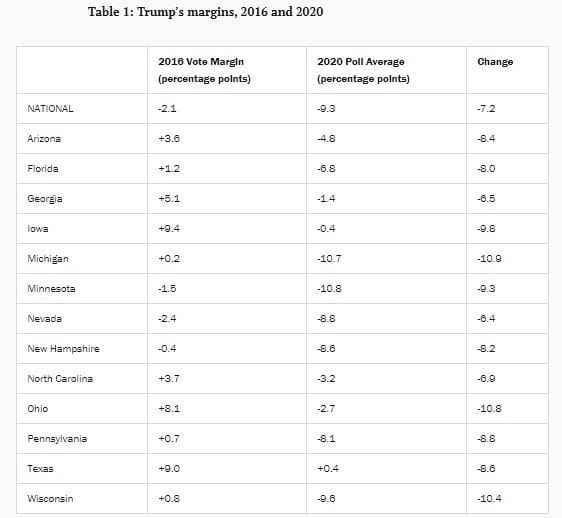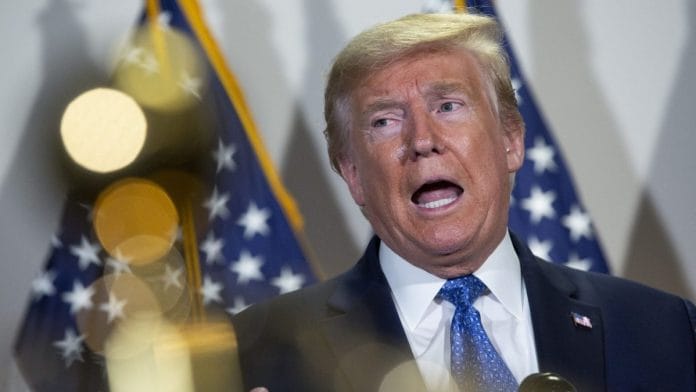The past three months have been a catastrophe for President Trump. With the odds against his reelection lengthening, and just 126 days until the election, the time to turn things around is dwindling. The president could still win a narrow victory, but only if everything breaks right.
A president’s job approval is the single most accurate measure of his political standing. As recently as April 1, Trump’s approval averaged 45.8%—about the share of the popular vote he received in 2016—and his disapproval 49.7%, his best showing since the first month of his presidency. By June 26, his approval stood at 40.6%, down 5.2 points, while his disapproval rose by 6.4 points to 56.1%.
In modern political campaigns, job approval is a good indicator of the popular vote percentage the incumbent president is likely to receive. The closer the contest gets to election day, the smaller the gap between these two metrics. During the past six elections involving incumbents (1980, 1984, 1992, 1996, 2004, and 2012), the difference between the president’s final pre-election job approval and his share of the popular vote has averaged about 1 percentage point.
Also read: Trump dismisses reports on Russian bounties to kill US soldiers in Afghanistan as ‘hoax’
In 2020, this convergence has already occurred. As of June 26, President Trump was averaging 41.4% of the vote in head-to-head contests with Joe Biden, just 0.8% higher than his job approval, and these numbers will be tightly linked between now and the election. If past is prologue unless he can raise his job approval significantly during the next four months, he cannot win.
This will not be easy. During the past six reelection campaigns, the only president who has been able to raise his job approval ratings by more than 6 points between June and November was Barack Obama. In 2012, he raised his approval from 46% to 52%, thus becoming the only modern incumbent to turn likely defeat into victory during his general election campaign.
Duplicating Obama’s impressive feat probably would not be enough to give President Trump a come-from-behind victory. A 6-point gain would bring his job approval to 46.6%. This was barely enough in 2016, and it almost certainly won’t be enough in 2020. In 2016, 6 percentage points of the total vote went to independent and third-party candidates, the highest by far since Ross Perot left the stage after 1996. Since then, the non-major party share has averaged about 3 points, a level to which it seems likely to return in 2020. If so, Trump’s 46% would leave Biden 50-51%—about what he is averaging right now, and more than enough to prevail in the Electoral College.
The optimists in the Trump camp might argue that the president’s support has declined far more in the blue states he never had a chance of winning than in the swing states he needs to reach 270 electoral votes. But the facts do not sustain this hypothesis. In fact, the president’s numbers in most of the states that could matter in 2020 have shifted against him more than has his national average, as the following table indicates.

In short, the decline in President Trump’s support since 2016 has not been confined to the blue states and has been close to uniform in the 13 states that could be in play in 2020. At the beginning of 2020, the Trump campaign believed that it could nail down the South and Southwest early in the contest and focus its resources on the states that made the difference in 2016 (Pennsylvania, Michigan, and Wisconsin) plus targets of opportunity such as Minnesota and New Hampshire. This plan is now obsolete. The president’s prospects in the Electoral College are dismal—unless he can raise his standing across the country.
Also read: Biden threatens sanctions against China over ‘death blow’ to Hong Kong’s autonomy
Although this is not impossible, it will be challenging. Three reasons for President Trump’s current plight—the public’s negative evaluations of his character, his handling of the COVID-19 pandemic, and his response to the killing of George Floyd—are unlikely to change significantly.
But five other factors could shift in the president’s favor. The economy could recover more quickly than economists now project; the protestors could overplay their hand by resorting to violence and tearing down statues without authorization; Trump campaign operatives could come up with effective lines of attack against Joe Biden’s record and character; the president could belatedly articulate a rationale for his second term; and the presidential debates could convince wavering Americans who might have supported Biden that he is too old for the job.
This is not close to an even-money bet. But it’s the best shot President Trump has left.
William A. Galston @BillGalston is Ezra K. Zilkha Chair and Senior Fellow – Governance Studies at Brookings Institution. Views are personal.
The article was first published on the Brookings Institution website.






